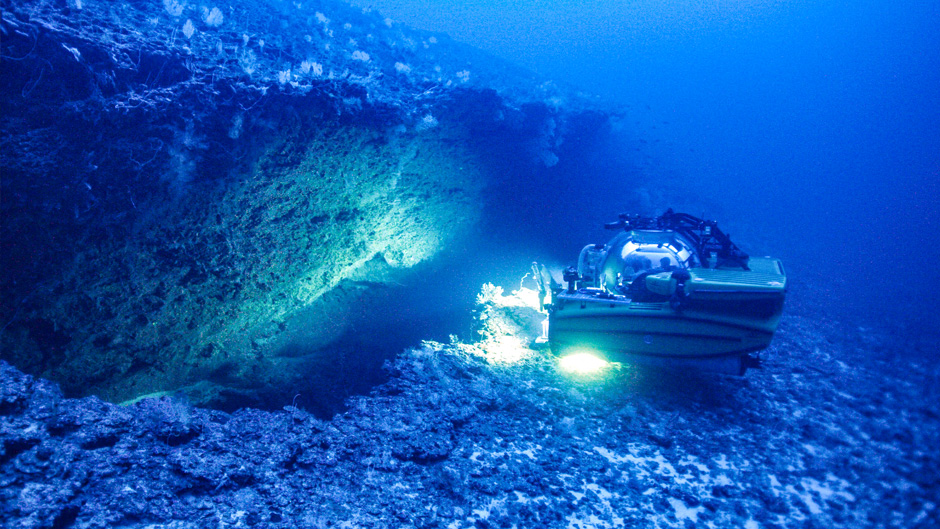Sam Purkis was halfway through a dive deep in the Gulf of Aqaba when he noticed something odd.
He and an accompanying scientist were finishing a 3,000-foot ascent from the seafloor in an OceanX submersible when he saw a startling break in the seabed.
But the professor and marine geologist had a hunch this was more than just a mere crack. In a body of water connected to the Red Sea—which was created by the divergence of two tectonic plates—Purkis knew there were other forces at play. Asking the pilot to stop and reverse, he saw a startling 15-foot-high fissure stretching across the seabed into the distance.
“Immediately, I realized that what we were looking at was the result of some tremendous geological force, which has broken the seafloor,” said Purkis, who chairs the Department of Marine Geosciences at the University of Miami Rosenstiel School of Marine and Atmospheric Science.
The ensuing scientific journey—to prove that an underwater landslide and tsunami occurred 500 years ago and to describe its implications for the region—was one of the most thrilling experiences of his career, said Purkis. He described his four-week voyage during a recent Sea Secrets lecture, and an article describing his findings was published recently in the American Geophysical Union Journal, Geophysical Research Letters.
“So far, it was the most exciting scientific discovery I’ve been involved in,” Purkis said, recalling the 2020 expedition aboard the OceanXplorer through the Tiran Straits, a narrow seaway that connects the Gulf of Aqaba to the northern Red Sea. The trip was sponsored by Neom, an organization working to develop the Saudi Arabian coastline. “We concluded that the seabed moved, part of the reef slope slipped downhill by a few meters, and then it got stuck, leaving a huge quantity of rock hanging precipitously above the abyss.”
The revelation also serves as a cautionary tale for the region. Since the break revealed a weakening of the reef slope along the eastern Tiran Straits, a busy shipping channel that separates Saudi Arabia from the bustling Egyptian resort town of Sharm-el-Sheikh, any more movement of the seabed could generate a very substantial tsunami, according to Purkis. Therefore, nations that border the Gulf of Aqaba, such as Egypt, Saudi Arabia, Jordan, and Israel, who do not all have effective early warning systems for earthquakes and tsunamis, should develop them, he added.
“There’s lots of earthquakes and shaking that goes on in the Gulf of Aqaba, and just a little shake in the wrong place and the whole [wall] could fail, leading to a much larger tsunami than occurred 500 years ago,” Purkis said. “That area of Egypt, as well as Saudi Arabia, which are urbanizing so rapidly, have certain hazards that haven’t been previously recognized. But they need to be, to avoid a future catastrophe.”
The newfound knowledge did not come without plenty of collaboration. After noticing the chasm in the wall, Purkis collected rock samples from the site and carbon dated them, which revealed that the movement occurred 500 years ago. He worked to verify this theory with biology professor Giovanni Chimienti of the University of Bari Aldo Moro in Italy, who was on the submersible with him, to confirm that the corals and sponges growing near the chasm were quite young.
Purkis then posited that the landslide likely triggered a tsunami, but he could not find historical evidence. So, he continued to look for geological proof. To do that, he moved to the north of the chasm, in much deeper water, and looked for a brine pool—a rare geological phenomenon where intensely salty water flows out of the seabed and accumulates in depressions, forming “lakes” at the bottom of the ocean. He searched for nearly eight hours in the darkness.
“With just two minutes left to go in our dive, we began to see the hint of an underwater lake, which turned into something much larger,” Purkis said.
It was the first brine pool discovered in the Gulf of Aqaba. The sediment beneath the pool was also uniquely undisturbed by burrowing animals because the pools are so salty, completely devoid of oxygen, and therefore, lethal to all organisms—apart from extremely hardy microbes. Taking samples from the bottom of the pool, Purkis was able to find evidence consistent with a tsunami 500 years ago.
He then connected with geophysics professor Steven Ward at the University of California, Santa Cruz, who created tsunami simulations of the event. Ward projected that a landslide of that size likely lasted just 10 seconds and could have produced a tsunami wave 30 feet high when it beached on the Egyptian coastline—much higher than the nearly six-foot wave that recently devastated the Kingdom of Tonga.
“The geological processes, which deliver the beauty of the Red Sea, also carry with them danger,” Purkis pointed out. “Earthquakes are common, and it seems that there’s real potential to generate a very large tsunami in this region. Our work suggests that this has happened before, and it will surely happen again.”

